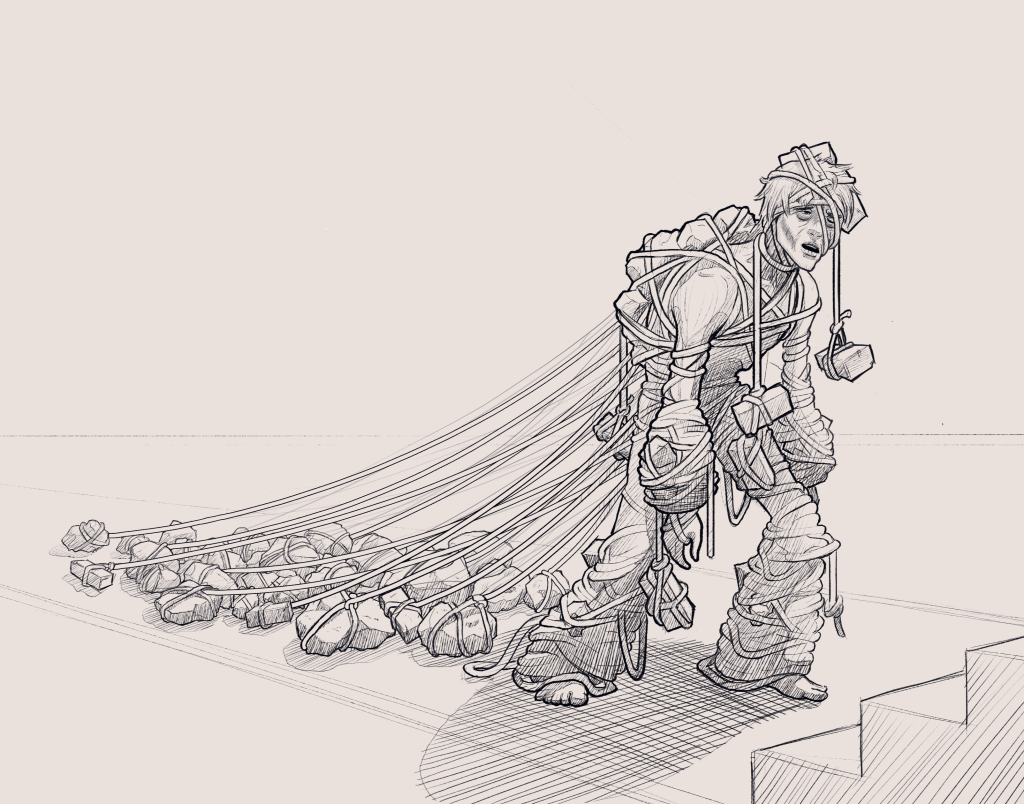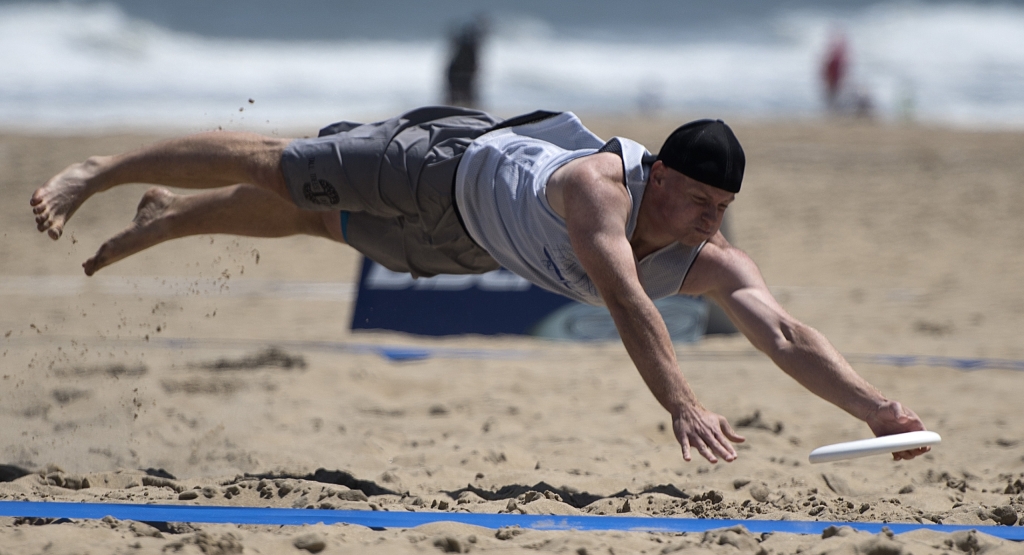Mostly, it feels like my body is wearing an invisible suit of armor, that, depending on the day, ranges in weight from 25 pounds to 100 pounds, making my limbs feel heavy and weak. When I stand, every signal in my body compels me to find support by leaning, sitting, or laying down. On more severe days, the latter is the only true bit of solace, and I rot in bed, rolling myself out only when I must use the commode.
It’s not “tired“. If it was, I could just sleep it off. This fatigue goes way beyond tired. Tiredness I feel in my eyes and brain, my eyelids drooping, compelling me to sleep. Fatigue I feel in my lower limbs, and all throughout my body, including my face and head. As soon as I wake up, I feel glued to my mattress.

an illustration by reddit user and fellow sufferer “mathavious” of the “heavy limbs, heavy body” feeling
Mentally, brain fog makes my head, brain, and face feel heavy and lays a pressured haze over everything I do. In front of my eyes, the world feels distant, and I find it difficult to be mentally present for activities I’d otherwise be engaged in, like meetings at work. The haze results in an aversion to anything requiring cognitive effort: on better days, I find it hard to use spreadsheets, do math, or read intellectual articles, on worse days, I can barely make it through a mindless YouTube video, and all I can do is turn my phone off and stare at the ceiling.
This isn’t me, but it’s the closest illustration of what my worst days look like
If, despite all this, I still exceed my energy limit for the day, I’m treated the next morning to “post-exertional malaise”, where I wake up feeling like I’ve been poisoned, feeling many of the physical signs of a hangover despite no alcohol having been consumed. This crash of malaise brings my baseline down even further, and I must rest even more to get back to where I was before the crash.
Then there are the eyesight issues, where, despite having almost no diopters in my prescription, the inflammation in my brain and optic nerve periodically reduces my vision to that of someone who needs glasses.
A disclaimer is to be noted at this point: every single person with Long COVID has a different set of symptoms, but I can only speak to my experience. I have the ME/CFS (myoencephalitis/chronic fatigue syndrome) variant of Long COVID. There are 3-4 different subtypes, all with their own mostly-unique symptoms, and some patients have many or all subtypes. I’m quite “lucky” that my 4-symptom presentation is so straightforward!
Here’s how I ended up in this situation:
On May 2, 2022, I got COVID. It really was not that bad, consisting of some light fatigue, and cleared up in a week. But five days after returning to health, I was suddenly and randomly hit with severe fatigue and muscle weakness. For three days, I lay in bed, barely leaving my apartment. After a week, this too cleared up. Though I didn’t know it at the time, this was my first bout of Long COVID.
Five weeks later, I caught a cold, which triggered another crash. I recovered again to 100%, but then crashed again three weeks later after lifting weights too soon after recovery.
The pattern kept repeating itself, sometimes with long breaks of full health in between, long enough to forget I even had Long COVID (or delude myself into thinking no longer did). Then I would either work out too hard, or get sick, and plunge again into the depths.
This cycle – crash, heal, crash again – has happened a total of eight different times in three years. The longest crash is happening as I write this: over three months.
I can hardly complain: my situation is heaven comparable to severe cases; there are people who have been mostly bed-bound for years. But on the other hand, the fact that the majority of my life I appear healthy to others lends a strange psychological dynamic to my condition. My illness feels invisible, and I feel somewhat reticent to bring it up, because it’s complex and hard to explain. Even though almost everyone I associate with has heard of Long COVID, it would be easier if I had cancer or something, a tumor that someone could visualize.
During my healthy periods, Long COVID is invisible even to me: I’m so healthy that I actually forget that I’m sick. That’s the reason I’ve crashed so many times – I get overconfident, start exercising more than I should, and crash. What’s worse is that the post-exertional malaise crashes take 24-48 hours to happen, so the feedback loop is long. I can do a workout, think that it went great, and then a day later suddenly be glued to my bed in the morning.
Working out has been part of my identity most of my life: I’ve been lifting weights since I was 19 and I dedicated a decade to playing ultimate at the highest levels. Right now, I’m not quite sure I’ll be able to do either of those again, at least not to the intense level I’m used to.

Something I’m not sure if I’ll be able to do again
But in viewing many recovery stories of chronic illness, I’m noticing a theme of “letting go”: releasing the idea that you will be the same person you were before, and making space for the person you’ll become. I’m trying to adopt this mindset, and with time, it’s getting easier.
Why is all this happening?
Though the true drivers of chronic fatigue syndrome are not certain, the main underlying issue is that my cells don’t process oxygen properly. In any other person, exertion results in aerobic exercise, where the mitochondria in the cells use oxygen to produce energy. Past a certain point, known as the anaerobic threshold, the cells run out of adequate oxygen and switch to using glucose to create energy. During anaerobic metabolism, lactic acid, lactate, and carbon dioxide all increase in the cells and endurance is reduced.
For someone with chronic fatigue, the anaerobic threshold is much lower, often just 50-60% that of a healthy person. If you’ve run a marathon before, or competed in a Crossfit competition, or played an ultimate tournament, you may have spent that evening and much of the next day on the couch, completely spent. For a sufferer of chronic fatigue, that same exhaustion is felt despite a much lower level of exertion, one that wouldn’t even faze a healthy person.
Depending on the severity of the condition, even banal acts like going to a party, walking around the block, showering, or picking up a fork causes us to switch from aerobic to anaerobic because there isn’t enough oxygen available to our cells, forcing us to rely on energy reserves we don’t have. And recovery from this anaerobic exhaustion takes much longer than a healthy person – even an ordinary task can cause a crash that takes weeks or months to recover from.
What helps me get better?
There are hundreds of procedures, supplements, and drugs that are purported to help with Long COVID. Reading patient forums, seemingly every recovery story praises a different solution, but if you dig deeper, most agree that almost nothing actually does much of anything.
I’ve tried dozens of interventions, but for me, only three things have ever worked beyond placebo: fasting, rest, and time.
I had never fasted before trying to heal from Long COVID, but since I’ve done over a dozen 24-36 hour fasts, after which my body typically undergoes a verx, an inflammatory immune response to stirred up “toxins” being cleared via autophagy. During this time, my symptoms actually get worse, which is scary. But afterwards, I feel noticeably better, more than any placebo.
The biggest healers, however, are rest and time. When I was in a bad place two years ago, my friend Jeff Ammons told me something I’ll never forget:
“The body wants to heal. You just have to give it what it needs to let it do its work.”
Mostly, that means doing nothing, which, for someone like me, is really hard. Twice, I’ve had to cancel all my summer plans: going out every single day, events, parties, meeting new people, being active, and instead stay at home, waiting to heal. The process can be excruciating, but it works. Long COVID communities are riddled with stories of people slowly getting better over a period of months, and sometimes even recovering to 100% health after years of resting.
With time and patience, I’ve recovered from every single crash, though recovery doesn’t mean that my body is at 100%: beneath the surface, inflammation still lurks, and I have to manage my activity and workouts to avoid straining myself. Still, the promise of a “normal” life is out there.
There are… dozens of us?
At least 1 in 6 Americans report having had Long COVID, so I shouldn’t be alone in this, though I feel like I am! I’ve only ever met two people who had Long COVID in real life, both were strangers, and I only met them once.
The main patient community, the covidlonghaulers subreddit, has only 71K subscribers, and I seem to be on the less severe end of at least those who post, but still, my guess is that my symptoms still put me on the more severe end of the entire population with Long COVID. Per the statistics, there should be millions of Americans who have it, but my guess is that they don’t feel it enough to seek out treatment communities, and they’re still able to live their lives without too much disruption – or they just accept that it’s going to be part of their life and don’t seek help… or worse, they may just suddenly “feel tired” and not realize they have Long COVID at all.
That being said, I’m looking to meet more people with Long COVID and give each other accountability in healing and researching our condition. There seems to be an over-surplus of anxious doomers that make this illness their identity and a relative lack of left-brained rational thinkers who are able to analyze the science and look for promising treatments and do what it takes to actually recover.
If you are on your own journey, please get in contact. Feel free to also send this article to someone that might need it if they want to get in touch as well.

Your experience sounds exactly like mine. Any updates on the battle with Covid?
Hey Jem, many updates. My understanding of my condition has deepened significantly since writing this, and I am now on a medical plan which I have hope will recover me. Feel free to get in contact (About/Contact) in the menu if you want!